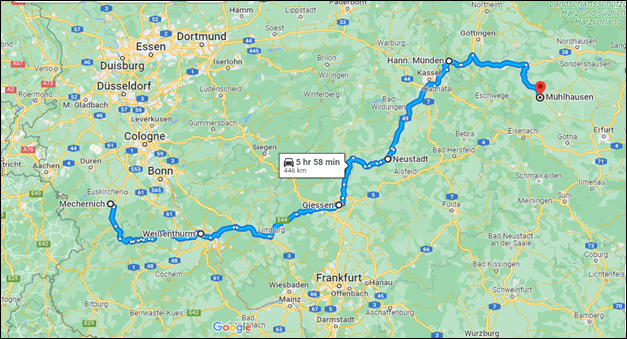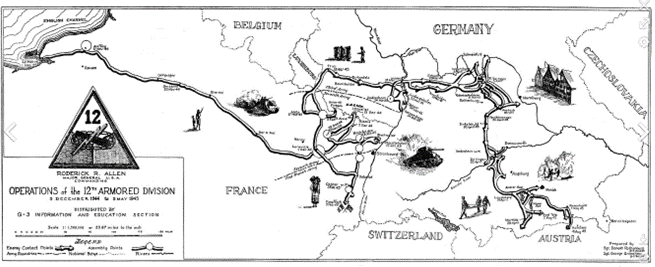
897th links: FRONT PAGE ...
897/3562 History ...
Camp Lee ...
Camp Shelby ...
Louisiana Maneuvers ...
Camp Murray ...
Train Trip ...
Camp Young ...
Palm Village ...
Camp Haan ...
Yanks in Britain ...
Normandy Hedgerow Cutters ...
Battle of Stavelot ...
Europe ...
Way it Was ...
WWII Memorial Dedication ...
Other WWII Stories ...
Notes and Contacts ...
gocek.org links: gocek.org ...
Christian Symbols ...
Financial Calculator ...
Football Pools ...
Captain Kangaroo ...
Webcam ...
Blogs ...
Statistics ...
Site policy information ...
The last thing a man wants to do is the last thing he does - Buffalo Bill
This account established through a few official records (the most vital of which are the accounts of company officers William Kemnitz and William E. Lake that the 3562nd Ordnance HAM Co. was activated in late January, 1944 (five months before the D-Day Invasion at Normandy).
The 3562nd reported to Camp Polk, Louisiana, and received training at Camp Forest, Tennessee that spring – being re-designated from a Medium Maintenance Company to "Heavy Automotive Maintenance Company" or HAM Co (responsible for light and heavy vehicle repair). On July 6 the Company moved to Camp Shelby, Mississippi. They were alerted for oversees action October 31; shipped out by rail to the East Coast on December 23 while the Ardennes Counteroffensive (aka Battle of the Bulge) had been raging for a week.
On January 1, 1945 the 3562nd arrived in Camp Kilmer, NJ and then Brooklyn, NY. The Company boarded Liberty Ship Sea Robin and set sail for Europe January 3. They arrived and docked at South Hampton, England January 16, then sailed to Le Havre, France on the same day. They left Camp Lucky Strike (Janville, France) on March 1st for Luxembourg, which had been liberated from German control in the fall of 1944 (though total allied control was not established until February).
Map of Allied Armies in Central Germany Invasion

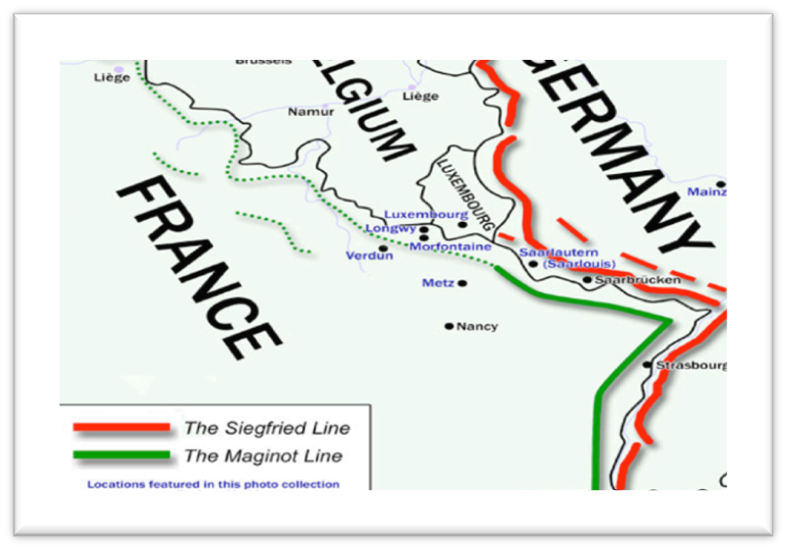
I believe that the 3562nd was to support the right flank (most southern) of General George Patton's 3rd Army as they drove
east across Central Germany – Operation Lumberjack. Patton's Army had already helped liberate Paris, and now had punched
a hole in the German lines turning back the German advance in the Battle of the Bulge in January 1945. Patton was decisive
and aggressive and didn’t like sharing the glory spotlight with other commanders. He would try to make history by being
the first to cross the beloved Rhine River, which ran south to north in the western interior of Germany. The Allied troops
regrouped, resupplied and amassed on the western border of Germany beyond the Moselle-Sauer Rivers. In early March the
Allied Armies crossed the Siegfried Line (heavily fortified western border of Germany) and began invasion of Germany.
It was at this time that the 3562nd saw its first "action" as they crossed the Sauer River from Luxembourg into enemy territory traveling and setting up safely behind the fighting divisions to service the light and heavy vehicles of the 3rd Army. The first location where the 3562nd "set up shop" was the captured town of Trier, Germany a few miles from the Luxembourg border on March 14, and remained there for about a week. Meanwhile, the US 3rd and 7th Armies were advancing north and east over rugged terrain in order to reach the broad river valley of the Rhine. There is an interesting account written by an artillery gunner Robert F. Gallagher in his memoir, Scratch One Messerschmitt, where he writes about what he and his anti-aircraft company experienced during World War II. Chapters 16-20 describe locations and events that were just few miles from the 3562nd and for the identical time frame as Roger's action in Germany! Chapter 16 is a brief account of their time in Luxembourg in preparation for the invasion – the same staging location as the 3562nd. Chapter 17 focuses on action in Alzey, Germany (just 10 miles southeast of where the 3562nd was repairing vehicles) to support a daring river crossing. In chapter 18 Gallagher's unit is assigned to Saint Goar northwest of Frankfurt to support a second river crossing. When they leave the location, the unit's transport truck breaks down on a remote road and they have to spend the night alone waiting for an Army tow truck. I wonder if Roger worked on that vehicle. Gallagher writes, "Moving through war-torn Germany was like observing a major catastrophe close up with the grieving and mourning survivors attending a prolonged funeral… Winston Churchill, the Prime Minister of England, said 'Germany has been ground to powder.' We observed that was only a slight exaggeration." The memoir is the best I have found to date to paint a picture of the setting and events that Roger must have experienced that spring. I highly recommend you navigate to it (entire book online) and read starting from chapter 16 - the description of the setting and events in Luxembourg before crossing the Siegfried Line. In chapter 17, Gallagher's anti-aircraft squad is heading for a destination in southwest Germany. Gallagher writes, "Soon we began to hear artillery fire. At first, it was like distant rolling thunder. Then it got louder and we could pick out individual volleys. We were headed toward the town of Alzey." They weren't told the nature of why they were commanded to position there, but soon it became clear. They were there to defend a cache of equipment and supplies to engineer the Rhine River crossing at Oppenheim, just south of Mainz – protecting it from the Luftwaffe that were active in the area. Gallagher describes that they could hear the guns of a major battle taking place to the northeast as the Army was attempting to secure this spot on the Rhine where army engineers would construct a temporary (pontoon) bridge.
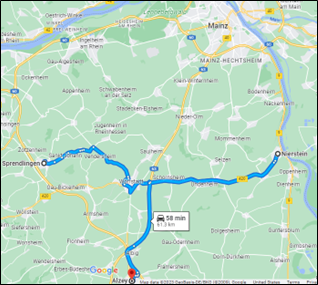
On March 24 the 3562nd Company was reported to be operating out of Sprendlingen near the Rhine’s west bank.
Patton's 3rd Army had already crossed the Rhine on the night of March 22 at Oppenheim and Nierstein just south of Mainz and
about 12 miles due East of Sprendlingen. I am all but certain the 3562nd used that army-engineered bridge to get to the 3rd
location, Langen (just to the south of newly captured Frankfurt) their reported location on March 30. These crossing points
were hugely strategic and therefore very active and perilous fighting locations.
Patton's Army seemed to be in a huge hurry – perhaps to be the first to cross the Rhine before the British Commander Montgomery; perhaps so that Hitler and/or his troops in Northern Germany couldn’t retreat to South-East Germany and hold out in the forests among the Swiss-Austrian Alps; perhaps he was also in a hurry to participate in the siege of Berlin and claim victory before the British or Soviets could claim it for themselves, or perhaps he was on a mission to rescue his son-in-law who had been captured and was being held in a POW camp in Hammelburg near Schweinfurt, Germany.
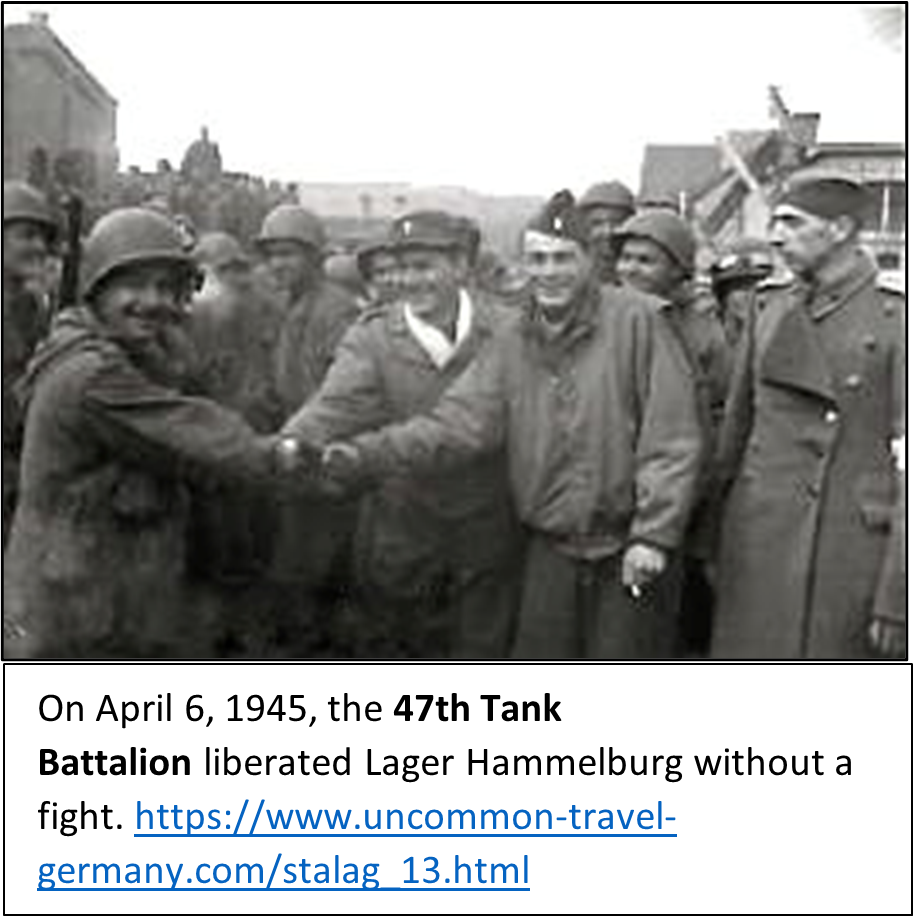
The US attack on Hammelburg on March 27 was a secret mission that put Task Force (Abraham) Baum, 300 men strong, 50 miles behind
enemy lines. The camp was breached by the task force, but the numbers of detainees were too great to get them out all out.
The task force took the highest officers but was ambushed on the way back to safety and a number of the rescued were
recaptured, and all 57 vehicles were destroyed. Only 32 men came back alive. It was arguably Patton's worst mistake of the war.
The POW camp would be freed 10 days after the ill-fated Baum raid.
Liberation of Lager Hammelburg

As mentioned before, the 3562nd was trained to repair light and heavy trucks. There is a very interesting Company called the
6th Armored Division (or the "super sixth") that begins the invasion of Germany under the command of General Alexander Patch's
7th Army on Patton's right flank, or a bit further south of the 3rd Army. Their first combat location is identified as
Zweibrucken, Germany just north of the French border, but they move northeast and by March 21 they are in Ebertsheim and now
under Patton's command. The 6th Armored Division and the 5th Infantry attack and capture Frankfort in a 4 day battle.
For footage of this battle use:
1st 90 seconds to view this group in action.
Frankfurt was captured on March 29, and the 3562nd was relocated to the east of the Rhine at Langen, Germany, just south of
Frankfurt by March 30. I believe the 3562nd probably repaired those Companies' vehicles, and they may have "shadowed" the
6th and/or 14th Armored Divisions and 3rd Infantry as they dashed east beyond Frankfurt.
Unfortunately, we are missing a data point for the 3562nd on April 8. The "record" reports them to be at "Lachs", but there is no Lachs, Germany and appears to be an error in the records. This date and location has been an obsession of mine for several years. Combing maps, records and researching the armored units' locations and the dates of captured towns east and northeast of Frankfurt has provided a set of plausible locations with one best fit, knowing that they needed to be relatively close to the west-east advancing allied divisions, while at the same time remaining safely behind allied lines. I have come to the conclusion that the missing location "Lachs" on April 8 is actually Lohr, or Lohr a. Main. As one can tell from the name, this small town is located along the Main River. Lohr is situated 20 miles east of Aschaffenburg (captured April 3) and was captured on or before April 4. Schweinfurt, a highly strategic industrial city located another 25 miles east would not fall until April 11. Lohr would have been a safe location for the 3562nd to set up shop on April 8. Once Schweinfurt was secured, units could travel safely east and north to, say, Eisfeld where the 3562nd was reported to be on April 16. Interesting side note: actress Marlene Dietrich came to Germany and performed a show for the 7th Infantry on April 11 at Fuchsstadt, Germany just 10-15 miles from Lohr. Were any members of the 3562nd at the show or allowed to attend?
UPDATE: I had the company at Lohr in early April, and I am discovering that can't be. Lohr and surrounding towns were captured by the 7th army. I have traced Patton's Third Army's actions and once they captured Frankfurt, they essentially drove north to meet up with Abram's First Army around Giessen, then turned east. Abram was delayed in deploying his forces on Patton's left flank, but Abram got a tip from a Germany defector around that time that there was a significant communications center at Ohrdruf about 30 miles beyond the Werra River. Patton ordered an armored division to capture it. They first captured the small towns of Vacha, Dippach and Merkers. I now believe Vacha is the so-called "Lachs" location of April 8. It makes sense in terms of central location of the Third Army's operations and nicely spaced from the 897's positions at Giessen, Forest Neustadt and Hann-Munden. At Merkers, the Army discovered the biggest treasure of the war hidden in salt mines. At Ohrdruf they discovered a huge underground communications bunker, and sadly the Ohrdruf concentration camp that was the first to be discovered and visited by Eisenhauer, Patton and the press.
Note from Gary, web site owner: "Lachs" appears to refer to a code name for a German aircraft factory hidden in a mine
in Walpersberg near Kahla. William Lake would not have known this code name at the time, but he may have heard it by the
time he compiled the condensed history. See:
Lachs aircraft factory.
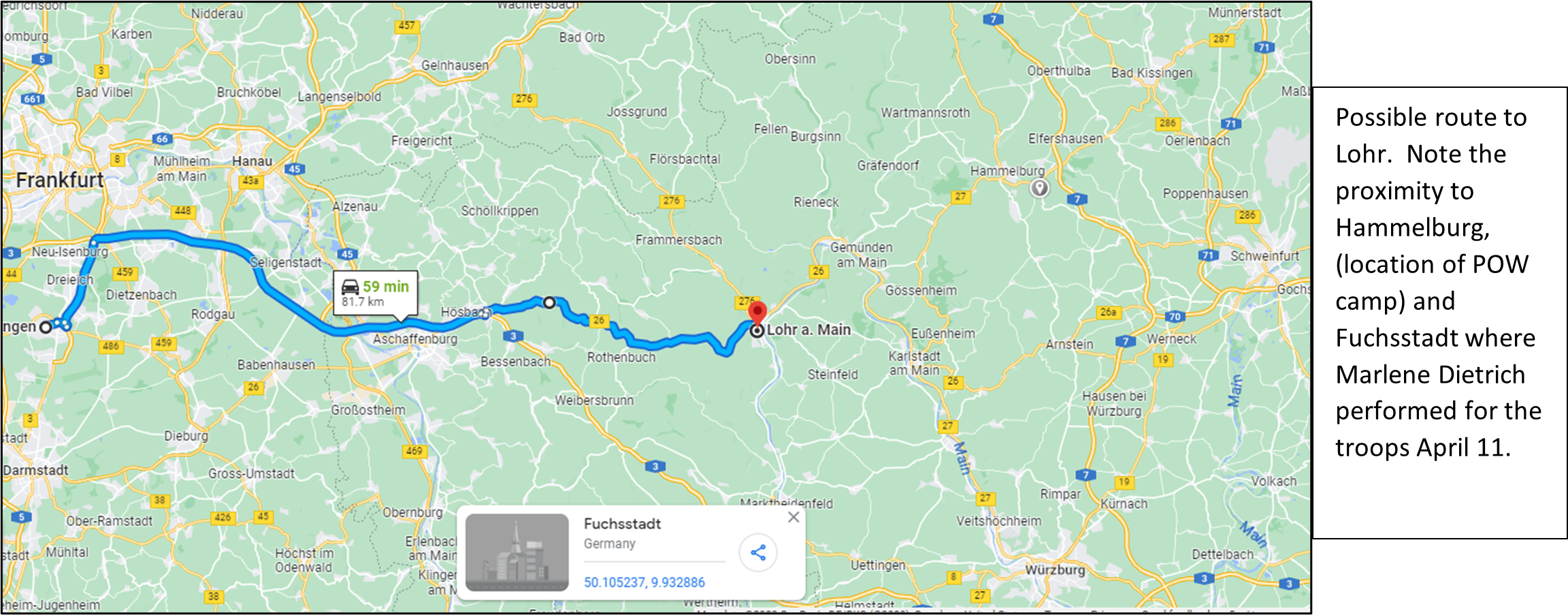
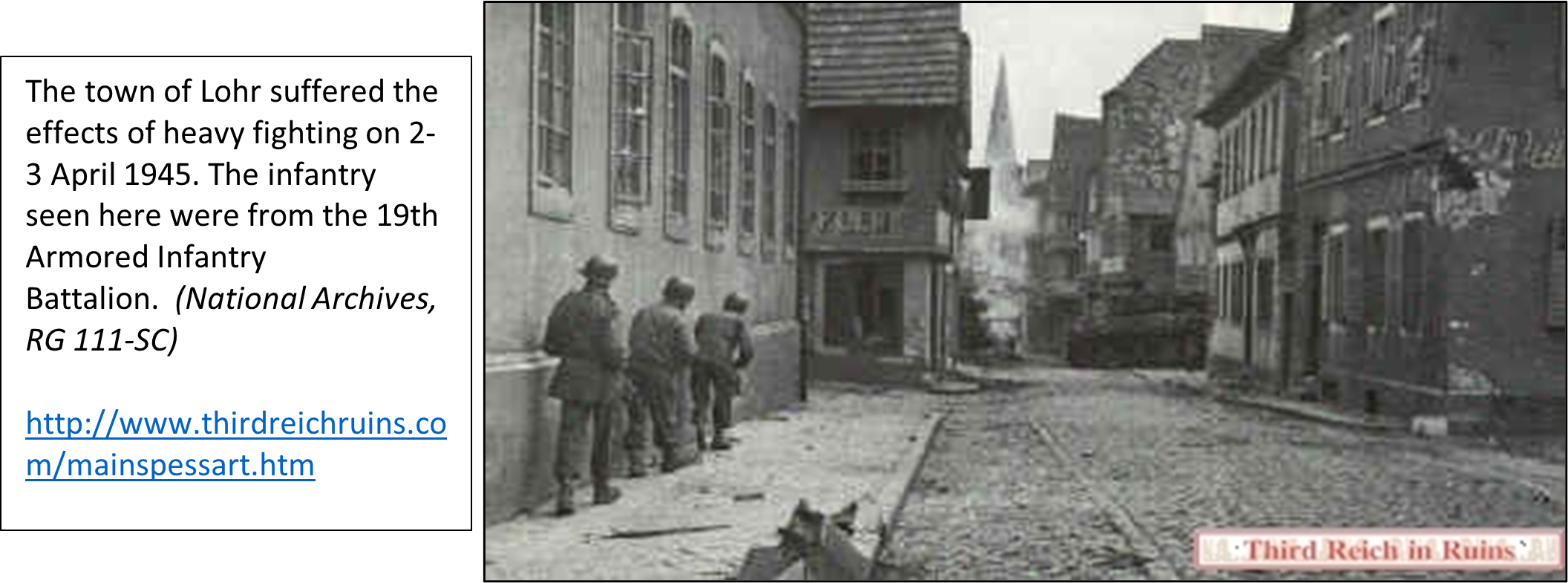
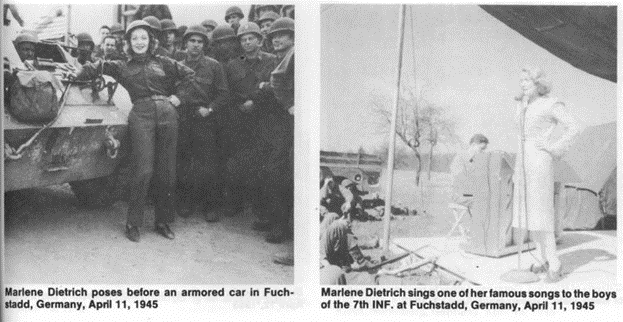
Having secured Aschaffenburg, Wurzburg and Bamberg, General Patch's 7th Army opened the way for the attack of Nuremberg (the political capital) from the east and north on April 16 (the same day as the start of the Battle of Berlin and the date 3562nd is reported to be in Eisfeld).
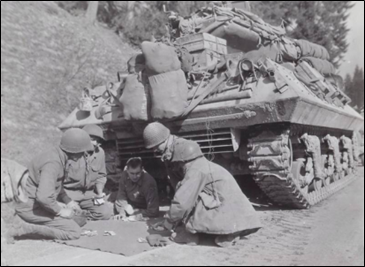
Bombed and shelled, the city surrendered by April 20, probably allowing the 3562nd to separate from the 3rd Army's Armored Divisions at Eisfeld and safely relocate on April 21 to Bad Berneck, and service battle-worn vehicles of the 7th Army. There, they took (or took charge of?) 15 prisoners. By April 29 they moved about 2.5 hours south to Wackersdorf, but they would have passed the road access to the infamous Flossenburg Concentration Camp near the Czech border where Germans held their most important political and military prisoners. I am sure the 3562nd had a LOT of vehicle work to do during this time (I imagine they were extremely busy during the entire campaign) but Hitler dies and Germany surrenders at the end of April, so the work load probably slowed, allowing Dad to get out and do some "sight-seeing". We have a handful of pictures of him at this time in bombed-out Nuremburg. Perhaps, Dad was able to see or participate in the closure of the Flossenburg Camp. All told, he and his Company were near at least 2 prominent Nazi camps, Flossenburg and the POW camp Hammelburg. Whether or not he directly observed or participated in the liberation of one or more of these camps is a matter of speculation. Certainly the 3562nd HAM Co were eyewitnesses to death and destruction on a massive scale. However, I believe it is safe to say that Dad and his Company helped provide the working vehicles for many heroic missions in the toppling of the 3rd Reich.
I hope this inspires you to fact-check and dig out more details about this chapter in our family’s history.
Bob
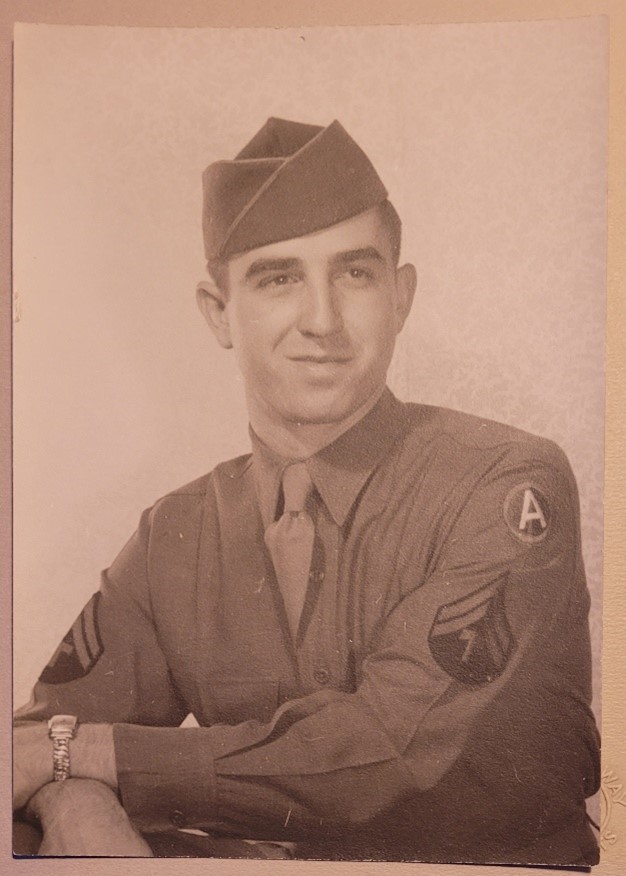
Roger B. Seiple WW2 US Army
Summarizing tour of duty map and Army Separation document.
Reported (or speculated) locations of the 3562nd HAMCo in March/April 1945 (exact routes unknown)
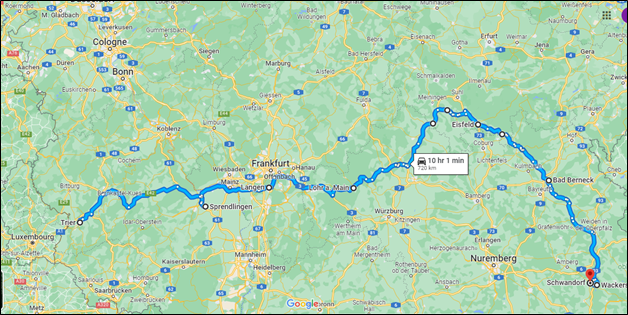
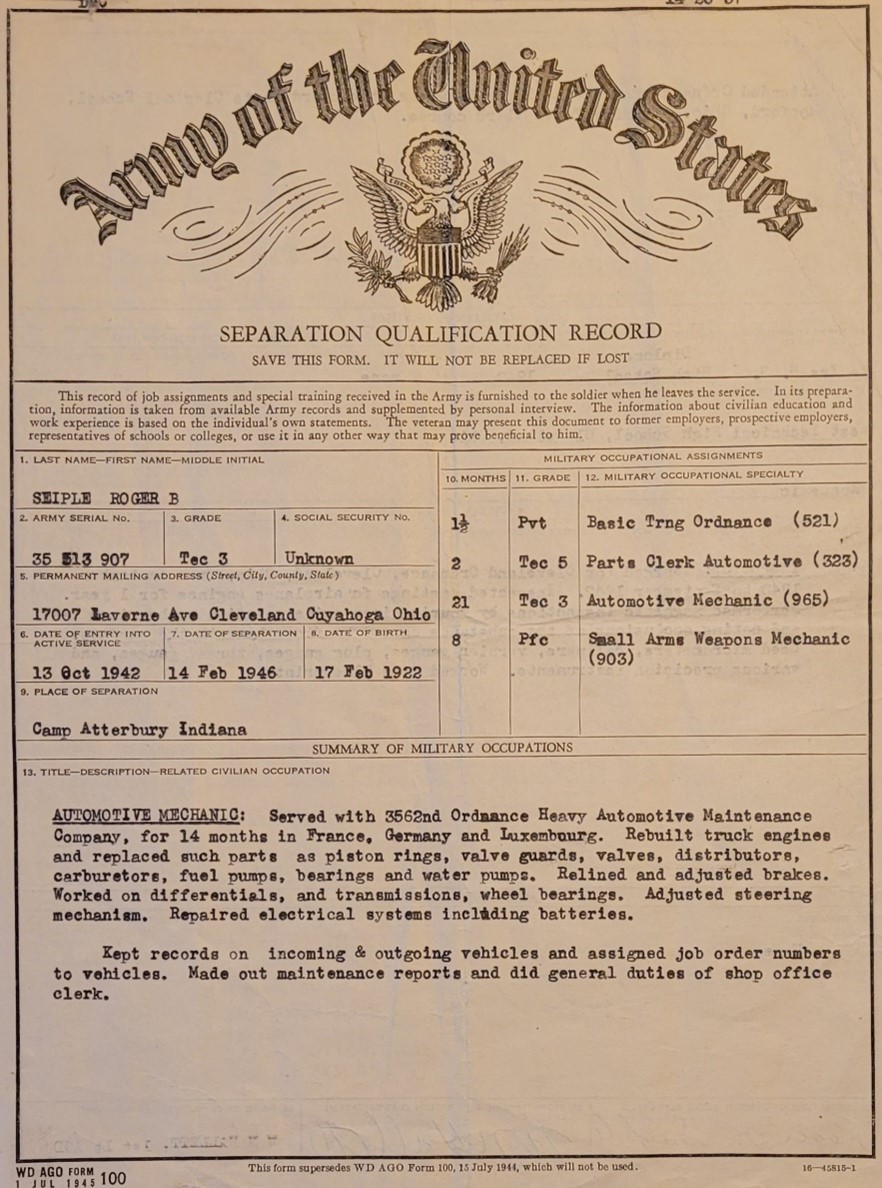
Movements with reported locations of the 897 HAMCo in March/April 1945 (exact routes unknown)
